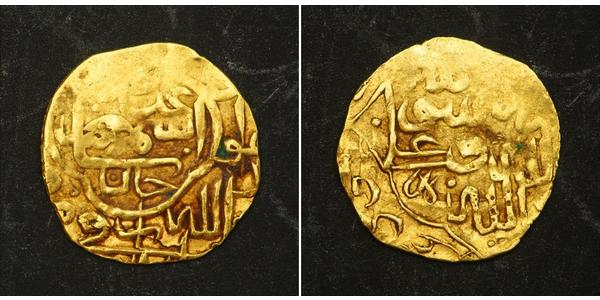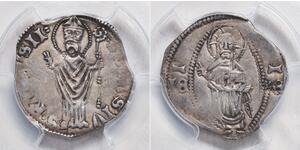(sold for $84.0)
1501-1524, Safavid Dynasty, Isma'il. Gold 1/4 Ashrafi Coin. (XF-) 0.77gm!
Culture: Safavid Dynasty Ruler Isma'il (1501-1504) Condition: Weakly struck area, minor deposits, otherwise VF+ Denomination: 1/4 Ashrafi Diameter: 13mm Weight: 0.77gm
The Safavid dynasty (/ˈsɑːfəvɪd/; Persian: دودمان صفوی Dudmān e Safavi) was one of the most significant ruling dynasties of Persia, often considered the beginning of modern Iranian history. The Safavid shahs ruled over one of the Gunpowder Empires. They ruled one of the greatest Iranian empires after the 7th-century Muslim conquest of Persia, and established the Twelver school of Shia Islam as the official religion of the empire, marking one of the most important turning points in Muslim history. The Safavid dynasty had its origin in the Safaviyya Sufi order, which was established in the city of Ardabil in the Azerbaijan region. It was of mixed ancestry (Kurdish and Azerbaijani, which included intermarriages with Georgian, Circassian, and Pontic Greek dignitaries). From their base in Ardabil, the Safavids established control over parts of Greater Persia and reasserted the Iranian identity of the region, thus becoming the first native dynasty since the Sasanian Empire to establish a unified Iranian state. The Safavids ruled from 1501 to 1722 (experiencing a brief restoration from 1729 to 1736) and, at their height, they controlled all of modern Iran, Azerbaijan, Bahrain, Armenia, eastern Georgia, parts of the North Caucasus, Iraq, Kuwait, and Afghanistan, as well as parts of Turkey, Syria, Pakistan, Turkmenistan and Uzbekistan.
Bidwith confidence!
Ismail I (Persian: اسماعیل, translit. Esmāʿīl, pronounced [esmɒːʔiːl]; July 17, 1487 – May 23, 1524), also known as Shah Ismail I (Persian: شاه اسماعیل), was the founder of the Safavid dynasty, ruling from 1501 to 23 May 1524 as Shah of Iran (Persia).
The rule of Ismail is one of the most vital in the history of Iran—before his accession in 1501, Iran, since its occupation by the Arabs eight-and-a-half centuries ago, had not existed as a unified country under native Iranianrule, but had been controlled by a series of Arab caliphs, Turkic sultans, and Mongol khans. Although many Iranian dynasties rose to power amidst this whole period, it was only under the Buyids that a vast part of Iran proper came under Iranian rule (945-1055).
The dynasty founded by Ismail I would rule for over two centuries, being one of the greatest Iranian empires and at its height being amongst the most powerful empires of its time, ruling all of present-day Iran, Azerbaijan Republic, Armenia, most of Georgia, the North Caucasus, Iraq, Kuwait and Afghanistan, as well as parts of modern-day Syria, Turkey, Pakistan, Uzbekistan and Turkmenistan. It also reasserted the Iranian identityin large parts of Greater Iran. The legacy of the Safavid Empire was also the revival of Iran as an economic stronghold between East and West, the establishment of an efficient state and bureaucracy, its architectural innovations and its patronage for fine arts.
One of his first actions, was the proclamation of the Twelver sect of Shia Islam to be the official religion of his newly-formed state, which had major consequences for the ensuing history of Iran. This extreme step, which had no principal in the history of Islamic states, was a rational one, granted that it was the "dynamic ideology" of radical Shi'ism that had roused his supporters.
Furthermore, this drastic act also gave him a political benefit of separating the growing Safavid state from its strong Sunni neighbors—the Ottoman Empire to the west and the Uzbek confederation to the east. However, it brought into the Iranian body politic the implied inevitability of consequent conflict between the shah, the design of a "secular" state, and the religious leaders, who saw all secular states as unlawful and whose absolute ambition was a theocratic state.
Ismail was also a prolific poet who, under the pen name Khaṭāʾī (which means "he who made a mistake" or "he who was wrong" in Persian), contributed greatly to the literary development of the Azerbaijani language. He also contributed to Persian literature, though few of his Persian writings survive.

|
Posted by:
anonymous 2018-05-29 |
1/2 Cent Kingdom of the Netherlands (1815 - ) Copper William ...
group has 10 coins / 10 prices
⇑
9 coins were uploaded from 2025-06-04 to 2025-06-11
One of them is:















-300-150-ZwusHgTycaAAAAGPadNVj7Mq.jpg)







